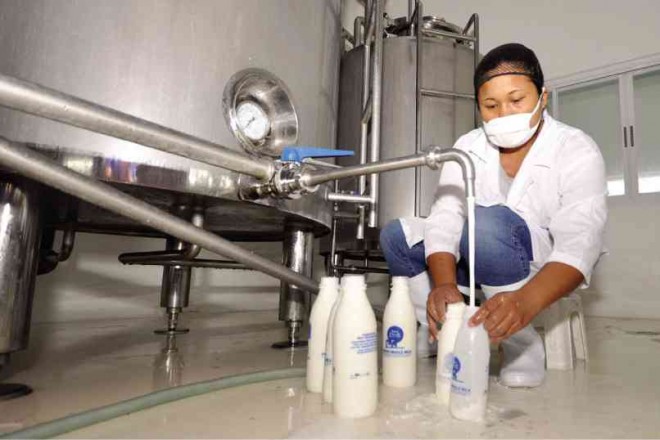
A dairy farm in Laoac town in Pangasinan province is no Charlie’s chocolate factory—no rivers or waterfalls of thick, luscious chocolates.
But the seven-hectare facility of the Pangasinan Dairy Multipurpose Cooperative flows with milk from its 300 cows in Barangay Maraboc.
During field trips, schoolchildren learn how Sun Fresh District Milk, the farm’s main product, is produced and processed so it is safe to drink. They also find out the difference between farm fresh milk and grocery fresh milk in cartoon boxes or in tin cans.
“We often get requests for educational tours from schools,” says Jazon Collado, the farm manager.
The children are fascinated by details explaining how milk is produced by cows and are often awestruck by the sheer number of cows in the area.
“We tour them around the farm. And if they are early enough, they get to see how carabaos are milked using portable machines,” Collado says.
The entire milk production process—from collecting raw milk from the cows to pasteurizing and finally bottling—is explained. The children peer through a wall of glass to witness how milk is stored in large tanks and poured into bottles.
“If there are less than 15 kids, and they behave well, we allow them into the building. The milk passes through tubes anyway, and these can’t be contaminated,” Collado says.
The young visitors also meet a cow named “Jumper,” which is able to leap over the fence when the cow is attracted by food.
Flavored milk
With its dairy project, the cooperative aims primarily to get more Filipinos to drink fresh milk. “We are getting there,” says Collado, a lawyer.
Filipinos love sweet drinks and sweet food and have not acquired the taste for fresh milk. This is why the milk factory also produces chocolate milk and milk flavored to approximate the taste of pandan and strawberry which are its best sellers.
But to discourage children from consuming sweetened milk, “we raised the price by almost double that of fresh milk,” Collado says.
The farm also produces milk-o-gel flavored with strawberry and chocolate, which is a hit among the kids, cottage cheese and yoghurt.
A liter of fresh milk is sold at P70 while the flavored one costs P120.
To those interested to learn about dairy farming, the farm is a training venue.
“We have trained around 500 aspiring dairy farmers, half of whom we have sent to Al Marai, the biggest dairy farm in Saudi Arabia through the Provincial Employment Services Office,” Collado says.
“Some trainees were also able to land employment in dairy farms in Japan. So we just don’t produce milk, we produce dairy farm workers,” he says.
The farm has four 80-foot high silos where corn, rice hay, molasses and minerals are kept to ensure that the cows are sufficiently fed each year.
“It is during the corn harvest season that the milk we produce is most delicious because the cows eat fresh corn plants,” Collado says.
According to him, cow’s milk is more “drinkable” than carabao’s milk, which is very creamy and is suited to making cheese, candies and ice cream.
The country’s milk requirements are 99 percent imported. The Laoac farm supplies milk to Baguio City, Subic town in Zambales and Pampanga provinces, where foreigners abound.
Regular customers visit the plant, especially on Saturdays, Sundays and holidays to buy milk.
Collado says putting up a dairy farm is expensive and difficult. This enterprise
requires a wide space to house imported cows. The processing (pasteurization) equipment are also costly.
Its P10-million machine was purchased from a grant from the United States Department of Agriculture and which was acquired through the Land O’Lakes Philippines Foundation.
“We are able to keep the prices of our products low because the money used to put up the farm was from the national government and the farm is operated by a cooperative,” Collado says.
Fast facts
40,322 Number of cows, carabaos and goats involved in dairy production in 2014
12,621
(in million liters) Total milk production of cows in 2013
6,566.14
(in million liters) Total milk production of carabaos in 2013
276.84
(in million liters) Total milk production of goats in 2013
1,945.61
(in thousand
metric tons) Volume of dairy imports valued at $857.19 million in 2013
Source: Bureau of Animal Statistics














































